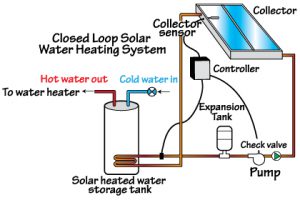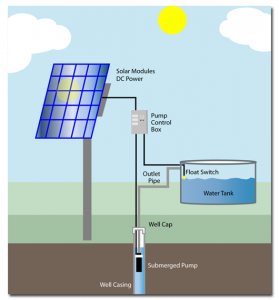We offer comprehensive, code-compliant systems that allow you to generate your own electricity at home. Designed to interconnect with your existing utility service, they feature solar modules, plug-and-play wiring, power electronics and our patented mounting kits. Our installer network provides system installation and service.
Solar cells in the modules mounted on your roof convert sunlight directly into DC power. A component called an inverter converts this DC power into AC power that can be used in your home. The system is interconnected with your utility. During the day, if your solar system produces more electricity than your home is using, your utility may allow net metering or the crediting of your utility account for the excess power generated being returned to the grid. Your utility would provide power as usual at night and during the day when your electricity demand exceeds that produced by your solar system. Systems are also available with a battery backup. Part of the power produced by your solar system during the day is used to charge the batteries, which provide power for your critical loads in the event of a power outage.
No. Sunlight must be present for your solar modules to produce power. At night, you draw power from your utility.
Yes, though they produce less electricity. Under a light overcast sky, panels might produce about half as much as under full sun.
While system sizes can vary greatly, a typical residential solar system will have a post rebate cost between $4,000 and $20,000.
This depends on a number of factors including your current cost of electricity, the rate structure of your electrical service, the incentives available to you, and the cost of money on your investment. When paying cash, a typical residential system may see a simple payback in 4-5 years. If you are financing the purchase of your solar system, you may see immediate positive cash flow or you may initially see a slight negative impact on monthly cash flow when factoring the cost of the loan against the initial savings. As electrical rates increase, and with your loan payment staying fixed, you will eventually see positive cash flow, a break-even point, and then a positive rate of return. Financed systems typically either see immediate positive cash flow or will attain positive cash flow within three years or so. How much space do I need for a residential solar system installation? Typical residential solar systems range from 3-10kW. Depending on the solar module, each DC kilowatt requires roughly 70 square feet of mounting area. So, for typical residential systems, you will need from 210 to 700 square feet.
No. Though the roof is the most common location for mounting solar modules, they can also be mounted on the ground or in other architecturally integrated ways such as on walls or shade structures. Ground mounted systems tend to cost more than roof mounted systems because of the need for trenching, concrete footings and (typically) a steel sub-structure. Ground mounted systems are, however, viable and common.
The main component of a solar system, the solar module, is typically warranted for 25 years but have a design life of over 40. There are modules still operating today that were manufactured in the 1970’s. The inverters are typically warranted for 10 years. It is not certain how long they may last beyond their warranty period. A conservative set of assumptions when considering the long term financial performance of your system is to figure the performance at 30 years with the replacement of the inverters at year 25. The inverters may represent roughly 10% of the post rebate cost of the system depending on system size, configuration and system installation cost.
Solar Modules are typically warranted to produce up to 80% of their original capacity up to 25 years. Different manufactures warrant the production degradation on different schedules. When comparing solar module warranties, read the warranties to determine which has the better coverage.
Washing the solar array with water a few times a year is a good idea but not strictly critical. Most good solar designers have factored the effect of seasonal dust on your projected system output over time. Occasional visual inspection of the array is wise in order to identify any serious soiling of the array such as significant bird droppings or other types of opaque soiling. Checking the integrity of mechanical and electrical connections, checking the electrical characteristics of the system and logging data are other good annual maintenance practices.
A maintenance contract with your solar contractor is a good idea to insure the continued optimal performance of your system. In addition to a thorough visual inspection of your system, a solar maintenance contractor can check mechanical connections, perform a re-torque of all electrical connections, take voltage readings of the individual PV strings in your system to confirm proper voltage and performance, and log cumulative data from your inverter(s) to keep and compare performance records for your system.
Most grid tied solar electric systems do not provide electrical power during electrical power outages. As a requirement of a grid tied inverter’s safety listing, it must shut down in the event of grid power loss. Backup power systems can be designed into a grid tied solar system with the addition of a battery bank and a battery powered inverter. This option adds complexity and expense that should be weighed against the benefit of having backup power.
Depending on which solar module is used, each DC (nameplate) kilowatt of PV will require roughly 85 square feet of roof space. So, a 4kW solar system will require roughly 340 square feet (4 x 85′ = 340 square feet).
Solar systems that receive government rebates typically require proof of approval from the building jurisdiction. Also, generally all electrical construction requires inspection from the building authority.
Yes. Off grid solar systems can be designed to power any home with modern systems and appliances. Though special appliances are not required, it is typically prudent to avoid any form of electrical heat such as electrical space heating or water heating and to rely on gas for providing energy for heat. Such gas heated systems (as well as electrical heating) can also be assisted by solar thermal collectors.
We offer two types of solar residential systems. One type of system powers your home during daylight hours but does not provide power in an outage, even on a sunny day. Another type of system powers your home during daylight hours but also has a battery backup designed to provide power to your home’s critical loads during an outage, day or night.
The array size you need depends on your average electrical usage, climate, roof angle, shading problems and many other factors. To approximate the array size you need, multiply your average daily electrical demand in kilowatt-hours by 0.25. The result is the approximate size of solar array, in kilowatts, needed to meet your electrical demand.
No. Regular solar panels designed for use in direct sunlight only.
This is the ideal situation for installing solar. Before laying the roof, you can install flash able mounting brackets that provide the highest level of protection from leakage.
Because of the wiring design of a solar module, all of the individual solar cells on a module must receive full sunlight for the module to work properly. If any portion of the module is shaded, the entire module power output-even those sections still exposed to sunlight-is lowered.
Each solar module is approximately 5 feet (1.5 meters) long and 2-1/2 feet (0.75 meters) wide. The modules are always grouped in a set of four, and the minimum number of modules for our smallest system is twelve modules. This requires an area of at least 120 square feet (11 square meters).
Solar electric power works for most homes. Our systems are engineered to work with most roofing materials, in most locations where direct sunlight is available, in almost every region of the United States. You need a sunny place on your roof about 120 square feet or 11 square meters (10 by 12 feet or 3 by 3.67 meters) for our smaller systems, and up to 1,000 square feet (93 square meters) for our largest systems. Shading from trees or other obstructions can reduce the practicality of a specific installation. A south-facing roof area is optimal, but solar electric panels can be mounted on west- or east- facing roofs and still produce better than 87 percent of the power of a true south roof mounting.
On-grid, grid-connected or grid-tied means connected to the utility electrical grid. Greeniverse solar electric systems are designed both on-grid systems and off-grid systems. On-grid systems interconnect with your existing utility service however Off-grid refers to systems that are not connected to the utility electrical grid. Our solar electric packaged systems are designed for on/off-grid applications. An off-grid system must be custom designed by our specialists.
No. Our solar power systems are designed to provide electricity to run your lights, appliances and other electric devices in your home. Other solar technologies are designed to turn the sun’s light into heat instead of electricity.
Solar electric modules are typically one to two inches (2.5 to 5 cm) thick with 32 or more three to four inch (7.5 to 10 cm) blue or black solar cells on the back of the cover glass. Solar water heating panels are generally much thicker and may have tubes connected to a flat black plate under the glass, or a black tank inside the collector panel.
No. People often confuse our products with solar thermal panels that involve water circulating through tubes to be heated by the sun for swimming pool water heating. Our solar modules convert sunlight into electric current to operate appliances, motors, pumps and other devices.
It is important to understand that a solar electric system does not need to provide all of the electricity you need to be of great value. A small system that displaces an average of one-quarter to one-half of your average demand reduces your electric bill. With battery backup, it can deliver uninterrupted power to critical loads during utility outages for days or weeks. We are happy to provide you with a system that supplies 100 percent of your energy needs, but cutting your electricity by 40 to 50 percent is typically the most cost-efficient approach for home solar power.
If a roof-mounted system proves impractical, a ground-mount, trellis or pergola application may be an option.
No. Solar electric systems are available only to property owners. The installation of a solar electric system involves the property owner entering a contractual agreement that includes a potential property lien (called a mechanic’s lien).
Net metering measures the difference between the electricity you buy from your utility and the electricity you produce with your solar energy system. Under net metering, any excess electricity produced by your solar energy system is delivered back into the utility grid, effectively spinning your meter backwards. Your meter spins forward when your solar energy system is not producing all of the electricity you are currently using. Your electric meter keeps track of this net difference as you generate electricity and take electricity from the utility grid.
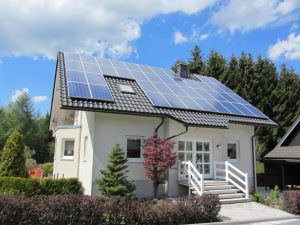
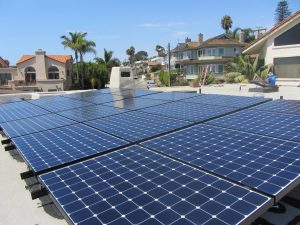
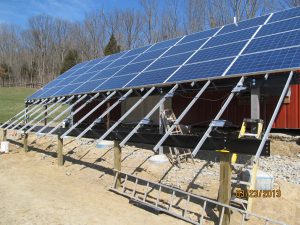
Many, but not all, states require utilities to offer net metering, but the size and technology requirements vary. If your state does not provide for net metering, you can still use the electricity in your house and enjoy the benefits of clean reliable power from the sun. However, you must purchase a second meter to measure the amount of electricity your system produces and make special arrangements with the utility to receive credit for excess electricity produced by your solar electric system.
Yes. State agencies and municipal utilities offer rebate and incentive programs for homeowners and small businesses to promote the installation of renewable energy equipment such as ours. Incentives can cut the cost of your system in half or one third, saving you thousands of dollars. Your dealer can tell you more about the incentives available in your area.
Our solar electric systems are designed to interconnect with existing utility service. Off-grid systems must be custom designed by a solar power expert.
Yes. In fact, our systems are designed as on-grid systems, meaning they are designed to interconnect with utility power.
Some homeowners’ associations have rules regarding the installation of anything on your roof or grounds. If you belong to a homeowners’ association, consult your covenants for details. Many states prohibit homeowners’ associations from restricting solar devices.
Yes. The local utility has rules and procedures that must be followed to connect any generator to the grid safely and legally. These rules are generally based on national standards with which our systems comply. Your dealer will help you with the documentation and procedures.
Yes. Your dealer and installer know how to obtain the necessary permits from your local government.
Since the maintenance required is very low, your cost should be minimal. Most of the related system components should last for many years without problems. The batteries in the residential system may need replacement every five to 10 years.
No. We do not offer an annual service contract. Your dealer may offer a service contract for regularly scheduled checks of the system output and wiring.
You should go years without problems. The batteries in our residential system may need replacement every five to 10 years. We recommend that the installer do a system check once a year, just to make sure everything is performing, as it should. If it is convenient, you can hose off the modules two or three times a year.
We provide a power meter with the system. Located in your home, your power meter tells you exactly how much electricity you generate and use, and when you send power back to the utility grid. You will be able to manage your household usage like never before.
With no moving parts and made of very inert materials, our solar modules are tough. Most of the related system components should also last for many years without problems. The batteries in our residential system may need replacement in five to 10 years.
The panels are supported by our roofer-designed mounting system that has been tested to withstand 125 mph (200 kph) winds and can work on almost every type of roofing material. Our modules can withstand one-inch (2.5 cm) hailstones at 50 mph (80.5 kph).
The amount of power produced by a system varies depending on the size of the system, your geographic location and climate and whether the system has a battery backup.



